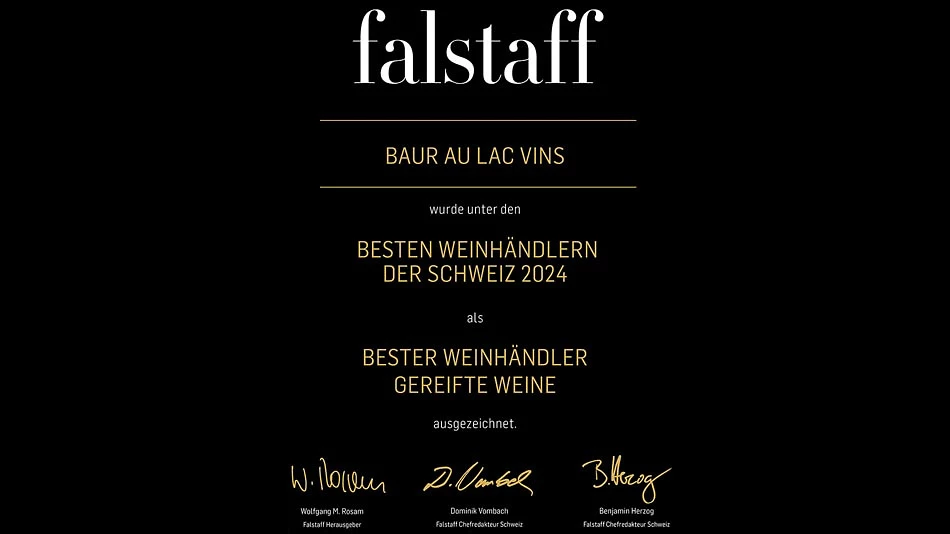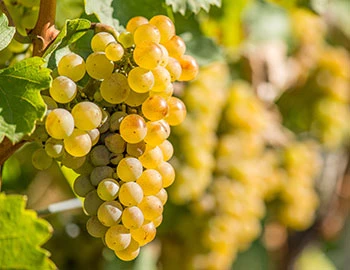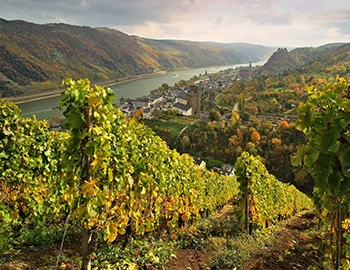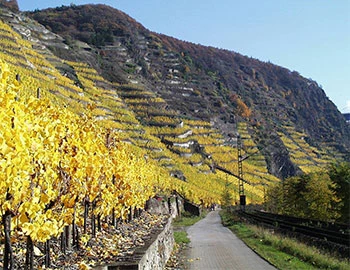Bacharacher Wolfshöhle Spätlese 2015
QmP Mittelrhein, Ratzenberger, 750 ml

| Grape variety: | Riesling |
| Producer: | Weingut Ratzenberger / Fam. Ratzenberger |
| Origin: | Germany / Mittelrhein |
Description
A lively, lusciously sweet Riesling with a bouquet of various citrus fruits. It shows a wonderfully broad spectrum of aromas with hints of blackcurrant, honey and herbs. On the palate it is opulent and creamy, but also very juicy. It is rounded off by a well integrated, animating acidity. The finish is long and fruity.
Best wine trader for matured wines 2024

Baur au Lac Vins was honoured by Falstaff as the best wine merchant for mature wines. Thank you very much for the award!
Attributes
| Origin: | Germany / Mittelrhein |
| Grape variety: | Riesling |
| Label: | Vegan |
| Ripening potential: | 5 to 20 years |
| Drinking temperature: | 10 to 12 °C |
| Food Pairing: | Italian antipasti, Apéro pastries, Vegetable dip, Fish ragout with saffron sauce, Cakes, biscuits, pastries |
| Vinification: | fermentation in wooden barrel, fermentation in steel tank |
| Harvest: | hand-picking |
| Maturation: | in steel tank, in large wooden barrel/foudre, on the yeast |
| Bottling: | filtration |
| Volume: | 8.5 % |
| Note: | Contains sulphites |
Riesling
The cold-weather king
The Riesling is the flagship of the German wine industry. It grows from north to south in all growing areas. It is also comfortable in the neighbouring Alsace region and in Austria. Its specialty is being vinified to a variety of degrees of sweetness, from bone-dry wines to ice wine. Moreover, thanks to its spirited acidity, it ages better than many reds. The typical Riesling smells of citrus, peach and apricot, shows hints of flint, and with maturity develops an idiosyncratic petrol note. It reflects its terroir like hardly any other white variety. Thus, it often gets fuller and more aromatic in Austria than in Germany. In Alsace, in turn, it has a particular mineral taste. Riesling is a wonderful culinary companion. It fits well not only with fish and shellfish, but also takes the heaviness from hearty meals. And with a fine sweetness and acidity balance, it works wonders for Asian cuisine.

Mittelrhein
Mittelrhein: small but fine
With a vineyard area of around 450 hectares, the Mittelrhein (or Middle Rhine) growing region is one of Germany’s smallest. It is bordered to the south by the Rheingau, following the Rhine’s course northward to Königswinter near Bonn, which is the northernmost winegrowing village on the Rhine. In the steep sites along the river, which are still cultivated delicately by hand, the leading variety, Riesling, develops across its entire spectrum, from dry to noble sweet.

Germany
Germany – Into the elite the hard way
Sitting in the heart of Europe, the hilly, lake-dotted landscape of Germany provides ideal, fertile soil for the most diverse vine varieties. From Albalonga to Zweigelt, over 140 different grape varieties are grown on about 100,000 acres, cared for by nearly 50,000 vintners. Most of these vintners are young, modern, internationally trained, inquisitive and urbane. It is hardly surprising, then, that German wine has a good reputation well beyond the country's borders.



